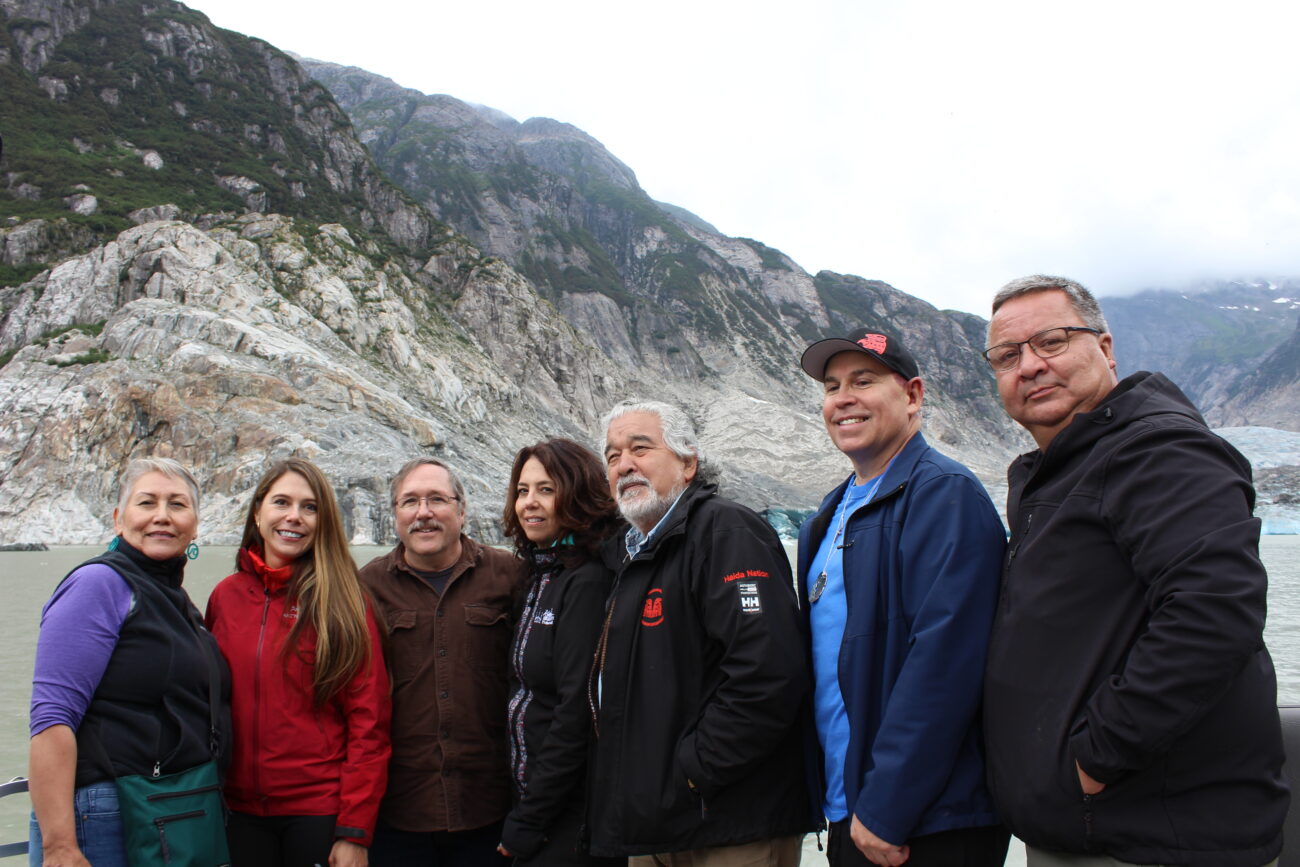
(Sage Smiley / KSTK)
Major river systems in Southeast Alaska start across the U.S.-Canada border, and natural resource development in the transboundary watersheds can have serious effects hundreds of miles away.
More than a dozen Southeast Alaska tribal governments and councils are asking the provincial government of British Columbia to recognize their sovereignty and give them a seat at the decision-making table when natural resource development could impact the communities downstream.
In early September, a small group from the U.S. and Canada took a trip to visit the Stikine River, the largest transboundary river in Southeast Alaska.
The ever-shifting tidal flats of the Stikine River delta are peppered with weathered tree trunks, the root systems sticking up like another small forest. For centuries, the Shtax’heen, the bitter water, and the surrounding land was the territory of Chief Shakes, the title passed through generations of leaders of the Stikine Lingít people.
The 1971 Alaska Native Claims Settlement Act extinguished what it called “aboriginal title” to the land, water, hunting and fishing rights.
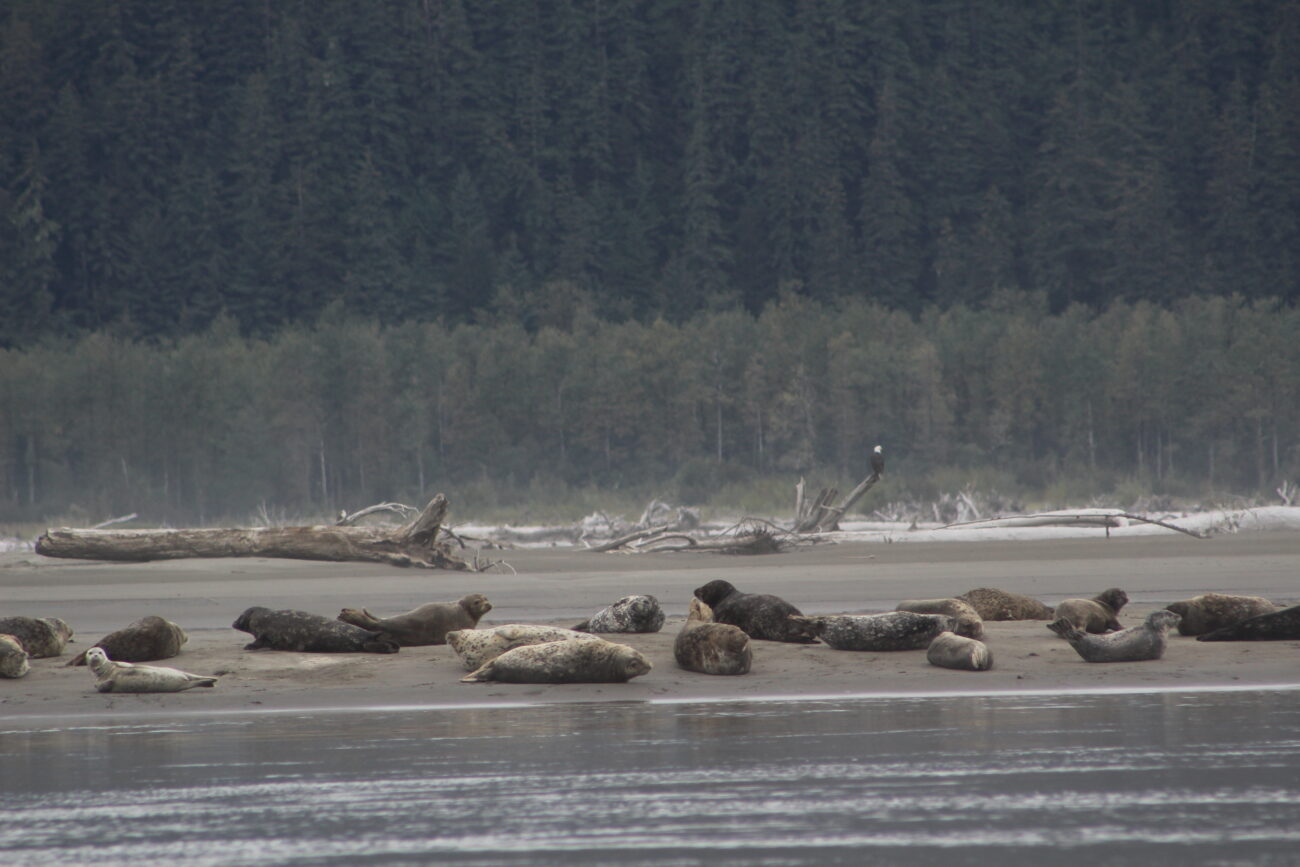
(Sage Smiley / KSTK)
“I call it the failed experiment,” says Rob Sanderson, the chair of the Southeast Alaska Indigenous Transboundary Commission. SEITC is a consortium of 15 Southeast tribal governments, which aims to protect rivers that sustain communities and culture in Southeast. Sanderson is standing on the back deck of a jet boat, idling just past the Stikine delta. “Now we’re all at a table like this,” he trails off.
Although Southeast Alaska’s Lingít, Haida and Tsimshian people are part of the same Indigenous groups that exist just a few miles upriver in Canada, Alaska Native people aren’t recognized as sovereign nations by Canada’s government.
“So then the issue is that the people who signed that thing have the authority to extinguish Indigenous people,” says Haida leader Guujaaw – who goes by his mononymous Xaad Kíl name. He’s standing by Sanderson on the deck, looking out at the Stikine delta. “Way back then, no one thought it would get this bad, eh? Back in the 50s, the land was intact, and the flag looks pretty nice.”
“Now that they’ve wrecked the earth and plundered most of it,” Guujaaw continues, “You can see the error. I mean, not just them [Alaska Native people], but Canadians and all over the world.”
The jet boat is carrying a cross-border group of environmental advocates and Tribal leaders upriver. Today’s focus is the Stikine, the fastest-flowing navigable river in North America. It was named one of the 10 most endangered rivers in America by nonprofit environmental organization American Rivers in 2019, because of the potential impacts of mine development.
The group includes Trixie Bennett, president of Ketchikan Indian Community; Haida leader Guujaaw of Skedans, Haida Gwaii; Dascawah Christie Jameison, assistant executive director of SEITC; Guy Archibald, SEITC Executive Director; Wrangell Cooperative Association council member Lovey Brock; Hup Wil Lax A Kirby Maldo, with SkeenaWild Conservation Trust; Meda DeWitt with The Wilderness Society; Irene and Dorian Dundas, also with Ketchikan Indian Community; Jared Paul of Seattle, Washington; Aaltséen Esther Reese, WCA Tribal Administrator; Tleek’ Tis Peterman, former SEITC executive director; as well as photographer Robert Johnson and boat captain John Verhey.
“Everything we protect is pretty amazing with what we’re up against,” Guujaaw says, “But yet, for our own people at the village level, it’s not a gain, it’s really just preventing a loss […] People look and see that the trees over there are still there, but that’s how it’s been forever. We didn’t gain anything by it.”
The commission (SEITC) is seeking what’s called the “right of consent” for Southeast tribes in the permitting process for a dozen operating and proposed mines in British Columbia. It’s a higher status than they’re currently afforded by the B.C. government, and would allow Southeast Alaska Native people the same rights as First Nations when it comes to free, prior and informed consent about the impacts of proposed mines.
Kirby Muldoe, whose Gitxsan name is Hup Wil Lax A, works with SkeenaWild, a Canadian conservation trust.
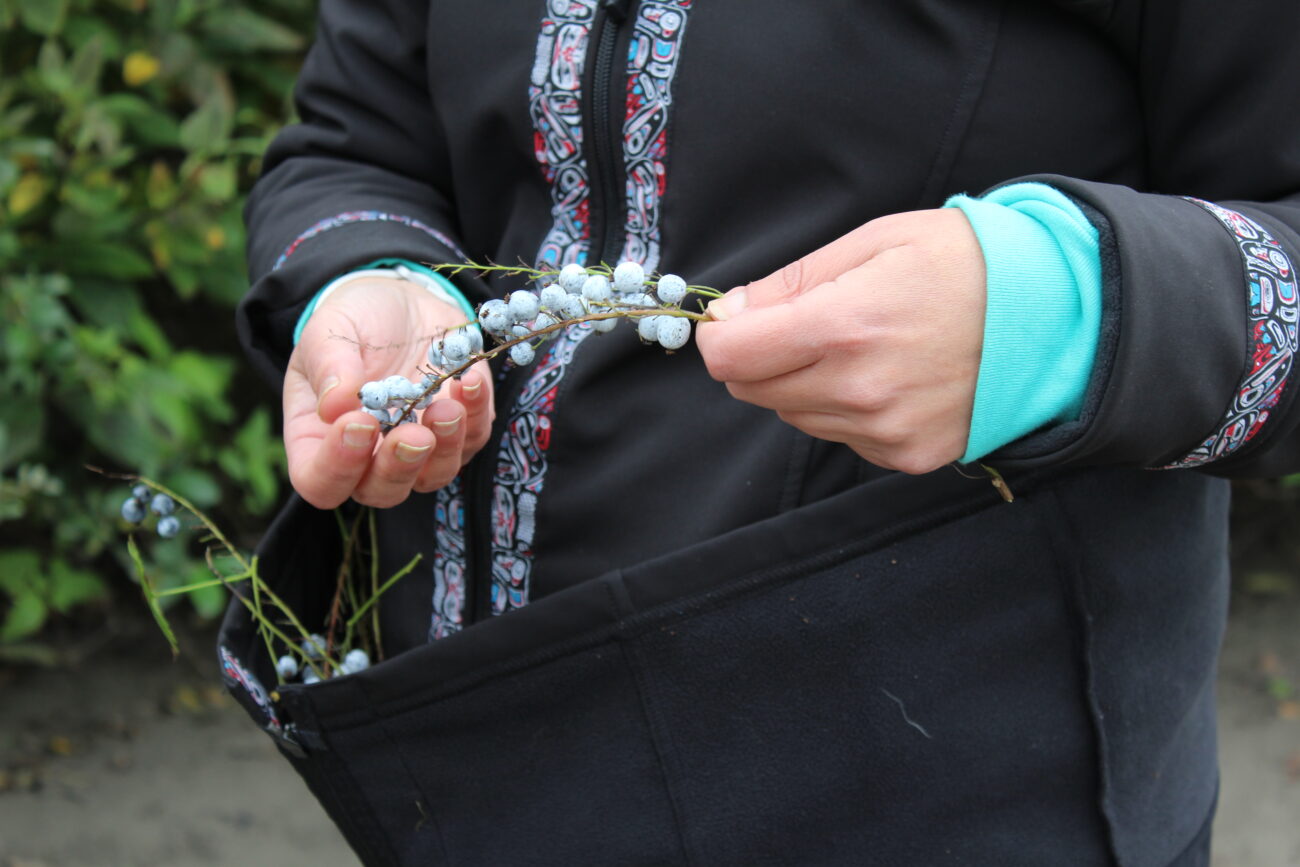
(Sage Smiley / KSTK)
“As we say about salmon, Muldoe says, “They know no borders.”
Last year, Canada signed the United Nations Declaration on the Rights of Indigenous Peoples, committing (among other things) to recognize the traditional territories of Indigenous groups. In theory, that could include the tribal commission’s request for participating First Nation status in the mining assessment and approval process.
A spokesperson with the government of British Columbia stated that B.C. follows existing agreements between the province and the state of Alaska and all applicable laws when it comes to involving Alaska Native groups in the mine permitting process. That framework means tribes can comment, but comments are taken on the same level as advocacy organizations or other public commenters, rather than as sovereign government stakeholders.
Standing on a sandy riverbank further upriver, Trixie Bennett has the bottom of her jacket folded up to form a pouch.
“Plants teach you,” Bennett says. “We learn out on the land, there’s lots of lessons on the land and plants help you remember.”
She’s filled the makeshift pouch with round, greyish-blue berries – stinkberries, or gooseberries. It’s a kind of currant.
“These are one of the late berries […] I think it’s a big part missing in our diet: berries,” Bennett says, removing fruits from thin green stems. “You need plants and vegetables – you need them to digest your foods, to get the most out of the fish that we eat, eh?”
Looking out at the silty water, she says Lingít creation stories center on the waterways of modern-day British Columbia and Southeast Alaska.
“We’ve always worked together on the river – managing it and our foods and building relationships,” Bennett says. “For a while, that stopped, you know, they built these boundaries, which you can clearly see when you got up the river, I don’t know if you’ve ever been up and seen the boundary line. But fish know no boundaries and neither do we.”
Bennett says her people have held the river in high esteem for generations, but they didn’t do it alone: “So this trip today is just another step towards reuniting with our cousins up the river. I’m a Lingít Tahltan, and up there are the Tahltan Lingíts.”
Bennett says being on the river feels sacred. It’s reclaiming a relationship – not only with First Nations but with the fish themselves.
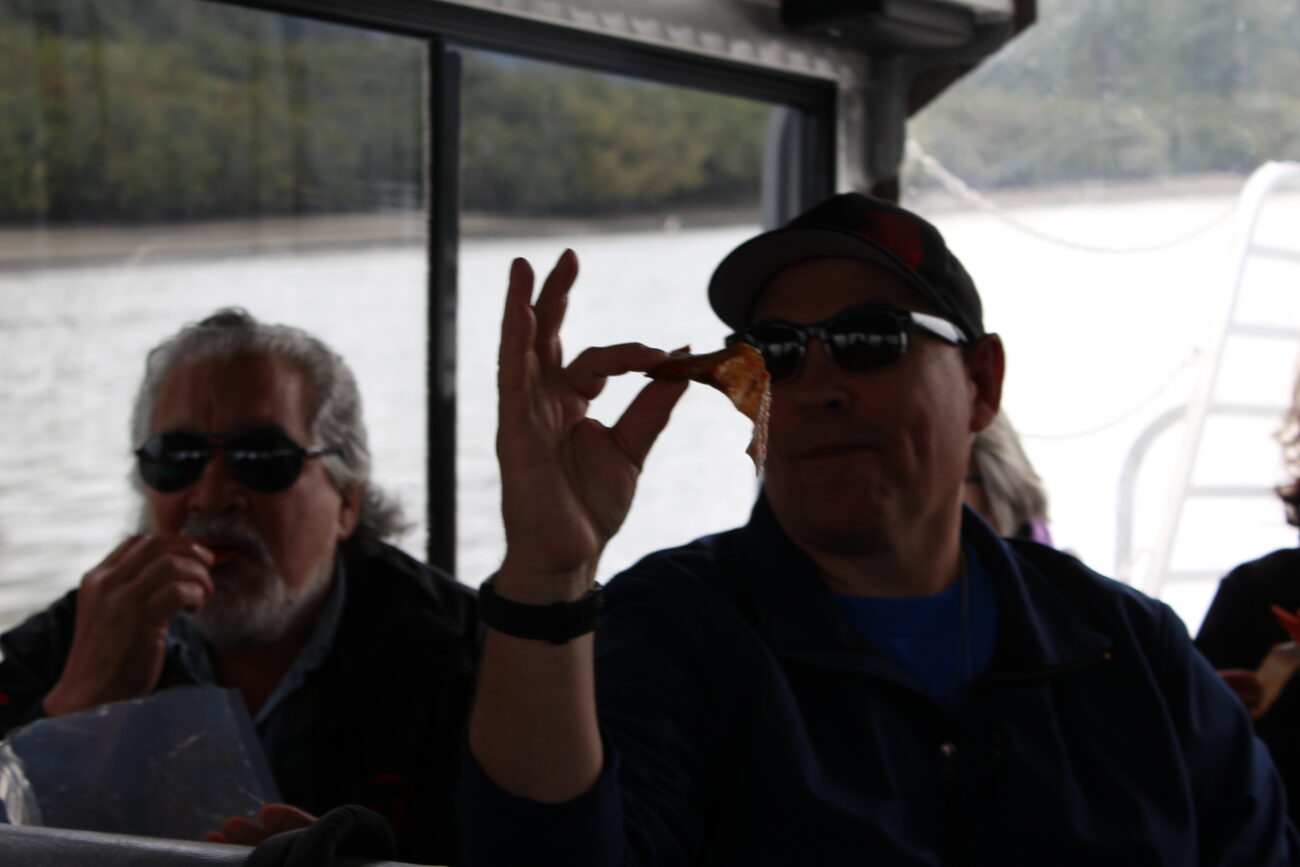
(Sage Smiley / KSTK)
“For thousands of years, our people have been the voice for the water and for the salmon and we’re always gonna keep on doing that,” she says. “For a lot of us here, I think this is the most important work that we’ll do – in this lifetime, anyway.”
Another few miles upriver and through a winding slough, pale blue icebergs start to dot the water.
Up this branch of the Stikine, Guujaaw says, may seem a long way from his home of Haida Gwaii, but the lands are all connected.
“If you look at the northeast corner of Haida Gwaii it’s all made of glacial till,” he says. “The sandy beaches all originate here from glaciers grinding up the thing and bringing it over to Haida country. So thank you very much to the Lingít and Tahltan people whose land is making all these lovely beaches for us.”
Muldoe, with SkeenaWild, says he’s amazed by the beauty and life upriver, and echoes Bennett, saying he feels being connected to the land is deeply important.
“A lot of people have lost that connection and we need to get back to the land,” Muldoe says. “We need to feel our feet on the land, in the water, we need to breathe the air, we need to drink the water.”
He continues: “I’m just so, so honored to be invited to Lingít territory on Lingít land up in Southeast Alaska and just to enjoy the beauty, to breathe in the air and feel the ancestors around us. It’s just amazing how life can exist here.”
In front of Shakes Glacier – named for the seven Lingít Chiefs of Wrangell who bore the name “Chief Shakes” – group members share songs and stories. Like glaciers throughout the world, this one is spectacular, and a visible reminder of the changing climate. The face of the glacier has retreated miles down the lake in the last few decades.
But the mood is exuberant and determined. For some on the trip, it’s their first time up the Stikine. For others, it’s a part of home. Aaltséen Esther Reese is the tribal administrator for Wrangell’s tribal government, the Wrangell Cooperative Association.
“I feel so at home on the Stikine,” Reese says. “My grandfather, when I was growing up, told me that our Tsaagweidí people came down from Canada down to Stikine and made our way to Kake. Interestingly enough, there is a painting in between here and Kake of people paddling.”
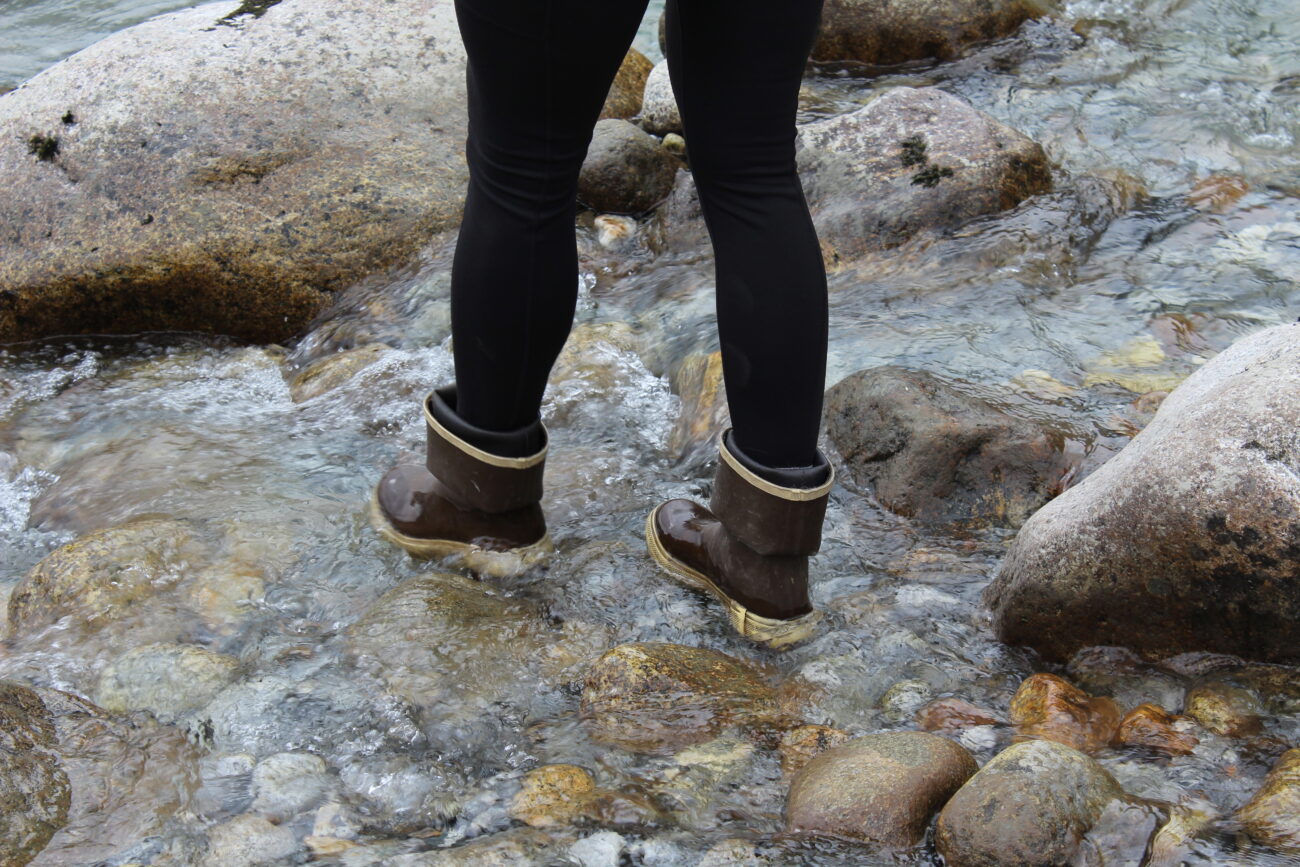
(Sage Smiley / KSTK)
Reese, who serves as Vice-Chair of the transboundary commission, was also recently elected to the steering committee of the Western Mining Action Network, an advocacy group focused on protecting communities from the adverse effects of mining activity.
“When I’m on the river, I can feel our ancestors with us, and I imagine them paddling down these rivers,” Reese says. “It is so extremely important for us to protect the rivers, to have co-management with our brothers and sisters in Canada. We have been here since time immemorial. We’ve always taken care of the land, and will continue to do so.”
The Stikine is one of three major transboundary rivers in Southeast Alaska – the others are the Unuk, near Ketchikan, and the Taku, near Juneau.
The largest mine in the Stikine watershed is the Red Chris Mine, operated by Imperial Metals since 2015. That’s the same company that owned the Mt. Polley Mine, which had a tailings dam failure in 2014, sending more than 6 billion gallons of mine waste into waterways in south-central British Columbia. It was one of the largest environmental disasters in Canadian history. The tailings dam which holds mine waste from the Red Chris Mine is more than twice as tall.
For now, though, the commission’s focus is on getting Southeast tribes “participating First Nation” status in the Eskay Creek Revitalization Project – the proposed reopening of a metals mine in the Unuk watershed. The draft environmental assessment for the project will come within the next year or two, and at that point, it will be more clear whether B.C. will allow Southeast tribes a seat at the table.
Get in touch with KSTK at news@kstk.org or (907) 874-2345.












